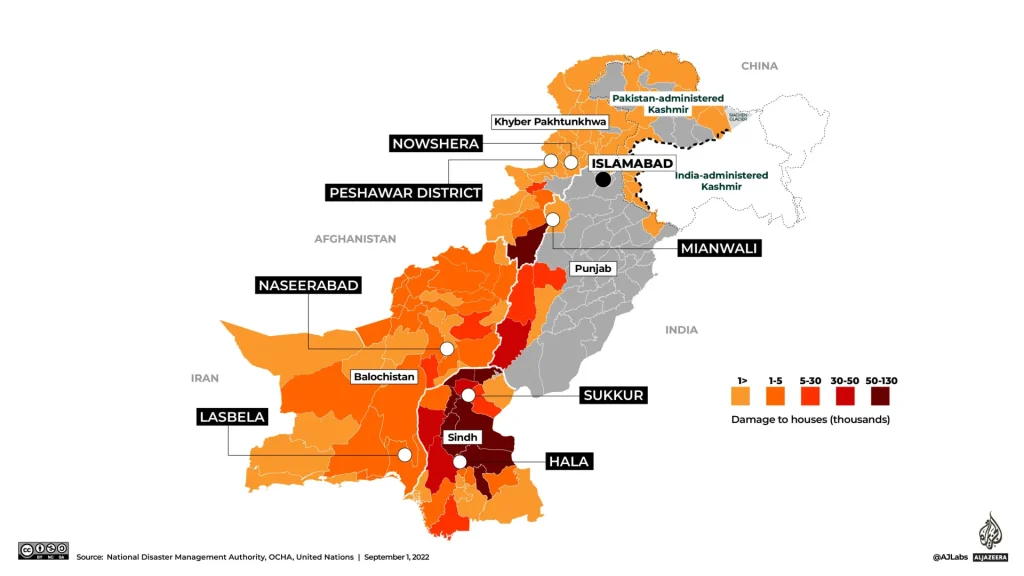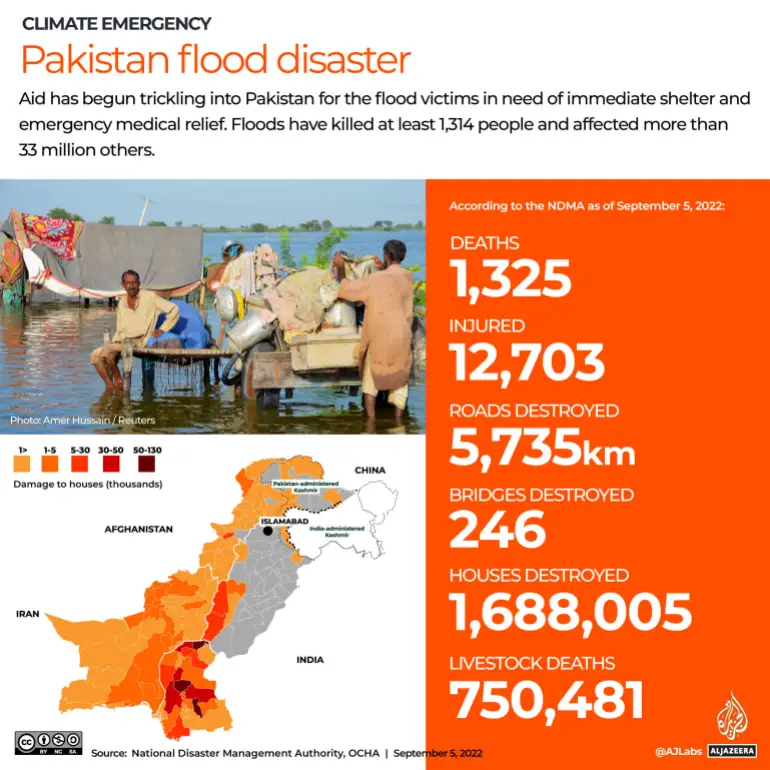Climate Change in Pakistan: Vulnerability, Impacts, and Policy Responses
Introduction
Climate change is no longer a distant concern—it is a lived reality for millions of people across the globe. Few countries, however, experience its severity as acutely as Pakistan. Despite contributing less than 1% of global greenhouse gas emissions, Pakistan ranks among the world’s top five most climate-vulnerable nations [1].
This paradox has turned Pakistan into a case study of climate injustice. While industrialized economies bear responsibility for historic emissions, it is developing countries like Pakistan that face catastrophic floods, extreme heatwaves, and melting glaciers. The challenge is clear: unless decisive action is taken, climate change threatens to unravel decades of socio-economic progress and push millions further into poverty.
This research article promises a comprehensive examination of Pakistan’s climate crisis. It will review the scientific, economic, and social dimensions of vulnerability, analyze sectoral impacts, evaluate national and international policy responses, and highlight pathways for sustainable adaptation. By integrating data from global institutions, government reports, and peer-reviewed studies, this article provides a holistic picture of where Pakistan stands today and what is required to secure its future.
Preview: In the following sections, we will first assess why Pakistan is considered one of the most climate-exposed nations, then explore the disasters already reshaping lives, quantify the economic losses at stake, and finally discuss solutions—from national policies to global cooperation—that could change the trajectory.
Table of Contents
Pakistan’s Vulnerability to Climate Change


Pakistan’s vulnerability to climate change is rooted in a combination of geography, socioeconomic fragility, and limited adaptive capacity. With its diverse topography—from Himalayan glaciers to arid deserts—Pakistan sits on the frontline of shifting weather extremes. Over 220 million people, many of whom rely directly on agriculture and water-dependent livelihoods, make the country particularly susceptible to climate shocks [2].
Geographic and Environmental Factors
Pakistan is home to 7,253 glaciers—the largest number outside the polar regions [3]. These glaciers feed the Indus River system, which supports over 90% of Pakistan’s agricultural production. Rising global temperatures have accelerated glacial melt, increasing the risk of glacial lake outburst floods (GLOFs) that endanger millions in northern regions [4]. Meanwhile, the country’s coastal areas, including Karachi, face sea level rise and intensified cyclones.
The variability of the South Asian monsoon further complicates Pakistan’s climate exposure. Shifts in rainfall patterns result in devastating floods in some years and prolonged droughts in others. This volatility undermines water security, agriculture, and energy generation.
Socioeconomic Exposure
Climate change intersects with Pakistan’s social and economic vulnerabilities. Roughly 40% of the population lives below the poverty line, with limited access to healthcare, education, and social protection [5]. Rural communities, particularly farmers, are disproportionately affected by droughts, erratic rainfall, and heat stress, leading to food insecurity and forced migration.
Urban areas are also at risk. Cities like Karachi and Lahore face rising temperatures, air pollution, and urban flooding. Heatwaves, such as the one in Karachi in 2015 that killed over 1,200 people in just ten days [6], demonstrate the deadly consequences of inadequate infrastructure and emergency preparedness.
Global Climate Indices Rankings
International assessments consistently place Pakistan among the most climate-vulnerable nations. The Germanwatch Global Climate Risk Index ranked Pakistan as the 5th most affected country over a 20-year period [7]. Similarly, the World Bank and UNDP warn that without effective adaptation, climate change could cost the economy over $1.2 trillion by 2050 [8].
- Germanwatch CRI: 5th most climate-affected nation (2000–2019)
- Population Exposure: Over 33 million affected in 2022 floods alone
- Glacial Risk: 3,044 glacial lakes formed; 33 considered hazardous [4]
Recent Climate Disasters in Pakistan


Pakistan’s vulnerability to climate change is no longer theoretical—it is manifesting through devastating climate disasters. These events have inflicted immense human, social, and economic losses, pushing millions into uncertainty and eroding resilience.
The 2022 Floods: Human and Economic Losses
The floods of 2022 stand as one of the most catastrophic climate-induced disasters in Pakistan’s history. Triggered by unprecedented monsoon rainfall, nearly one-third of the country was submerged [9]. Over 33 million people were affected, 8 million were displaced, and at least 1,739 lives were lost [10].
The economic cost was staggering: damages and losses exceeded USD 30 billion, while reconstruction needs were estimated at USD 16 billion [11]. The floods destroyed 2 million homes, damaged 13,000 kilometers of roads, and wiped out large swathes of farmland, crippling food supply chains. This single disaster demonstrated the destructive potential of climate extremes when combined with fragile infrastructure and governance gaps.
Glacial Melt and GLOF Events
Pakistan’s northern regions are at the epicenter of glacial melt. Warming temperatures have led to the formation of over 3,000 glacial lakes, of which 33 are classified as dangerous [12]. Glacial Lake Outburst Floods (GLOFs) pose a constant threat to communities in Gilgit-Baltistan and Khyber Pakhtunkhwa.
These events not only endanger lives but also damage infrastructure, farmland, and hydropower stations. The UNDP-supported GLOF-II project highlights that over 7 million people are at risk of sudden flood surges [13]. As glaciers recede, water flow in the Indus basin becomes increasingly unpredictable, with long-term implications for agriculture and energy security.
Heatwaves and Rising Temperatures
Pakistan has witnessed alarming spikes in temperature over the past two decades. The 2015 Karachi heatwave remains a stark reminder: more than 1,200 people perished in just ten days due to extreme heat, compounded by power outages and inadequate medical response [14]. Studies suggest that heatwaves in Pakistan are becoming longer, more frequent, and deadlier due to climate change [15].
In 2022, temperatures in Jacobabad and Dadu exceeded 51°C, among the highest ever recorded on Earth [16]. Such extremes jeopardize human health, reduce labor productivity, and strain already overburdened healthcare systems.
Droughts and Water Scarcity
Alongside floods and heatwaves, Pakistan also struggles with recurrent droughts. Provinces such as Sindh and Balochistan frequently face water shortages that disrupt agriculture, force migration, and intensify poverty cycles. Water scarcity is further exacerbated by declining rainfall in arid regions, poor irrigation management, and competing demands across sectors [17].
The country’s per capita water availability has dropped to under 1,000 cubic meters per year, placing it in the category of “water-scarce nations” [18]. This scarcity threatens not only food security but also national stability, as disputes over water resources intensify.
Sectoral Impacts of Climate Change
Climate change is reshaping Pakistan’s economy and society across multiple sectors. Agriculture, energy, health, and urban development are all directly exposed to shifting climate patterns. Understanding these impacts is critical to designing effective adaptation strategies.
Agriculture and Food Security
Agriculture contributes nearly 20% to Pakistan’s GDP and employs about 40% of the labor force [19]. Yet it is the sector most vulnerable to climate stress. Erratic rainfall, prolonged droughts, and rising temperatures have already reduced crop yields. For instance, wheat production declined by 4.2% in 2022 due to climate-related disruptions [20].
Projections suggest that yields of staple crops such as wheat, rice, and maize could decline by up to 47% by 2050 if climate change remains unmitigated [21]. This would have devastating implications for food security, especially for low-income households that spend a majority of their income on food.
Livestock, another cornerstone of Pakistan’s rural economy, also faces threats from heat stress, reduced fodder availability, and increased disease outbreaks. Climate-induced migration from rural to urban areas is expected to intensify as agricultural livelihoods become unsustainable.
Energy Sector and Renewable Transition
Pakistan’s energy sector is heavily dependent on water resources. Hydropower contributes nearly one-third of electricity generation, making it vulnerable to fluctuations in river flows caused by glacial melt and changing rainfall patterns [22]. Reduced water availability threatens energy security, while extreme heat increases demand for cooling, further straining the grid.
On the positive side, Pakistan has pledged to achieve 60% renewable energy in its power mix by 2030 [23]. Solar and wind capacity have grown rapidly in recent years, with solar power nearly doubling between 2022 and 2025 [24]. However, scaling these solutions requires sustained investment, grid modernization, and regulatory reforms.
Health and Public Safety
Health impacts of climate change are already visible. Beyond heat-related deaths, climate change contributes to the spread of vector-borne diseases such as dengue and malaria [25]. Flooding events create breeding grounds for mosquitoes, while warmer temperatures expand the range of infectious diseases.
Malnutrition is another growing concern. Climate-induced crop failures reduce food availability, increasing the prevalence of stunting and wasting among children. The World Health Organization warns that without urgent interventions, climate change could reverse decades of progress in Pakistan’s public health indicators [26].
Urbanization, Migration, and Climate Refugees
Climate change is accelerating the pace of internal migration in Pakistan. Floods, droughts, and declining agricultural productivity are forcing rural populations to seek livelihoods in urban centers. According to the World Bank, over 10 million Pakistanis could be displaced by climate-related disasters by 2050 [27].
This rapid, unplanned urbanization poses significant challenges for cities like Karachi, Lahore, and Peshawar. Already burdened with inadequate housing, poor sanitation, and congested transport systems, these cities struggle to integrate incoming populations. The result is the growth of informal settlements and heightened risks of urban flooding, heat stress, and disease outbreaks.
The phenomenon of “climate refugees” is expected to intensify socio-economic inequalities. Vulnerable groups—particularly women, children, and the elderly—face heightened risks of exploitation, unemployment, and health insecurity during displacement.
Read More About: Swat flash flood 2025
Economic Implications
Climate change is not just an environmental concern; it is a profound economic challenge for Pakistan. Estimates suggest that without adaptation, climate change could reduce Pakistan’s GDP by up to 18–20% by 2050 [28]. This loss translates to over USD 1.2 trillion in damages, undermining growth prospects and exacerbating poverty.
GDP and Macroeconomic Costs
The 2022 floods alone wiped out 2.2% of GDP growth in a single fiscal year [29]. Agricultural losses, disruption of industrial production, and damage to infrastructure all contributed to this economic setback. Moreover, climate risks increase borrowing costs and deter foreign investment, as international markets perceive Pakistan as a high-risk environment.
Projected Losses by 2050
By mid-century, Pakistan’s climate-linked costs are projected to surpass USD 1 trillion [30]. Rising sea levels threaten Karachi’s coastal economy, while melting glaciers put long-term hydropower and agriculture at risk. The human capital impact is equally significant: declining labor productivity due to heat stress could cut national income by an additional 5% [31].
Financing Needs for Adaptation
Pakistan requires at least USD 348 billion by 2030 for climate adaptation and mitigation efforts [32]. This includes investments in resilient infrastructure, renewable energy, early warning systems, and sustainable agriculture. Yet current domestic financing falls short, forcing Pakistan to rely heavily on international climate finance mechanisms such as the Green Climate Fund and multilateral donors.
Pakistan’s Policy Response
Pakistan has taken notable steps to address climate change, though implementation challenges remain. The government recognizes climate change as a cross-cutting issue affecting all sectors, and its policy frameworks reflect this urgency.
National Climate Change Policy (2012 and Updates)
The National Climate Change Policy (NCCP) of 2012 laid out Pakistan’s roadmap for mitigation and adaptation [33]. Its updated frameworks emphasize renewable energy, disaster preparedness, and afforestation. However, policy translation into practice is uneven, largely due to limited institutional capacity, fragmented governance, and funding constraints.
10 Billion Tree Tsunami and Afforestation Efforts
One of Pakistan’s most high-profile initiatives is the Billion and later 10 Billion Tree Tsunami Project, aimed at large-scale reforestation. By 2023, over 3.5 billion trees had reportedly been planted nationwide [34]. Independent audits, however, raised questions about transparency and survival rates of plantations [35]. Despite criticisms, the initiative has been recognized globally as a significant step toward carbon sequestration and ecosystem restoration.
FAQ
The following frequently asked questions address common concerns about climate change in Pakistan, integrating key findings from this research.
Why is Pakistan considered highly vulnerable to climate change?
Pakistan’s geography, dependence on the Indus Basin, and socio-economic fragility make it one of the most exposed nations. It ranks among the top five countries most affected by climate disasters, despite contributing less than 1% to global greenhouse gas emissions [36].
How did the 2022 floods impact Pakistan?
The 2022 floods displaced 8 million people, killed over 1,700, and caused USD 30 billion in damages. Nearly one-third of the country was submerged, highlighting Pakistan’s acute vulnerability to monsoon variability [37].
What role do glaciers play in Pakistan’s climate crisis?
Pakistan has over 7,000 glaciers, the highest number outside polar regions. Melting glaciers form hazardous glacial lakes that can burst and trigger floods, threatening millions of people in Gilgit-Baltistan and Khyber Pakhtunkhwa [38].
What policies has Pakistan introduced to fight climate change?
Pakistan has adopted the National Climate Change Policy (2012), renewable energy targets of 60% by 2030, and major afforestation projects like the 10 Billion Tree Tsunami. While ambitious, these policies face challenges in financing and implementation [39].
How much funding does Pakistan need for climate adaptation?
According to UNDP and World Bank estimates, Pakistan requires USD 348 billion by 2030 to adequately adapt to climate change and build resilience [40].
International Cooperation and Climate Finance
Pakistan cannot confront climate change alone. Given its limited fiscal space and disproportionate vulnerability, international cooperation is critical. Multilateral organizations, development banks, and bilateral donors play a vital role in strengthening Pakistan’s resilience.
Green Climate Fund Projects
Pakistan has secured approximately USD 249 million through the Green Climate Fund (GCF) for seven major projects [41]. These include initiatives on ecosystem restoration, renewable energy, and climate-resilient agriculture. While the funding is significant, it remains far short of Pakistan’s adaptation needs, estimated at USD 348 billion by 2030.
Multilateral Partnerships
The World Bank, UNDP, and Asian Development Bank (ADB) have been active in financing climate resilience. For instance, the World Bank supported the Post-Disaster Needs Assessment (PDNA) after the 2022 floods, which guided reconstruction priorities [42]. Similarly, UNDP has invested in GLOF-II, an early warning and community preparedness program in the northern areas.
Loss and Damage Negotiations
At COP27, Pakistan emerged as a leading voice for climate justice. It successfully advocated for a “Loss and Damage” fund to support countries suffering from climate impacts beyond their capacity to adapt [43]. This achievement underscores Pakistan’s growing role in shaping global climate negotiations, though accessing these funds will depend on robust institutional frameworks and transparent mechanisms.
Case Studies
Real-world examples illustrate the urgency and complexity of Pakistan’s climate crisis.
Glacial Lake Outburst Floods in Gilgit-Baltistan
In 2022, a GLOF event in Hunza destroyed bridges, farmland, and homes, cutting off access to entire communities [44]. Localized adaptation efforts, including community-based monitoring and reinforced embankments, have shown promise but require scaling nationwide.
The 2015 Karachi Heatwave
The deadly heatwave in Karachi, which claimed more than 1,200 lives, revealed the intersection of climate extremes and urban fragility [45]. Poor urban planning, lack of green spaces, and inadequate healthcare infrastructure amplified the disaster. Since then, heat action plans have been piloted in Karachi, but nationwide frameworks remain underdeveloped.
Flood Resilience Programs in Sindh
After recurrent flooding, Sindh initiated flood-resilient housing projects supported by NGOs and international donors. Elevated housing, improved drainage systems, and community awareness programs reduced vulnerability in targeted villages [46]. These localized successes highlight the importance of integrating climate adaptation into development planning.
Challenges in Implementation
Governance and Institutional Weakness
Pakistan’s fragmented governance structure often leads to overlapping responsibilities across ministries and provinces. This reduces efficiency in implementing climate policies and projects. Political instability further complicates long-term planning.
Data Gaps and Research Capacity
Reliable climate data is essential for forecasting and adaptation. However, Pakistan suffers from insufficient weather stations, outdated modeling tools, and limited research funding. This lack of robust data hinders evidence-based policy design [47].
Financing and Corruption Concerns
Climate finance remains constrained not only by global shortfalls but also by domestic inefficiencies. Allegations of mismanagement in large-scale projects like the Billion Tree Tsunami raise concerns about accountability [48]. Transparent monitoring and evaluation systems are critical to ensuring that climate funds achieve their intended goals.
Future Outlook and Recommendations
Pakistan stands at a crossroads. While the threats are immense, timely interventions could transform its vulnerability into resilience.
Science-based Policy Design
Policies must be grounded in climate science and regularly updated to reflect changing realities. Investment in climate research institutions, universities, and data networks is essential for long-term preparedness.
Community-Led Adaptation
Empowering local communities to develop and implement adaptation solutions ensures greater ownership and effectiveness. Village-level disaster committees, women-led farming cooperatives, and youth-led awareness campaigns are proven models.
Digital Solutions and Climate Innovation
Technology can play a transformative role. Mobile-based early warning systems, satellite monitoring of glaciers, and AI-driven agricultural advisories can bridge knowledge gaps and enhance resilience. Pakistan’s growing digital ecosystem offers untapped opportunities in this space [49].
Private Sector and Green Investments
Mobilizing private sector capital is crucial. Incentives for green financing, tax benefits for renewable projects, and partnerships with startups can accelerate climate innovation. International investors are increasingly interested in climate-smart projects, provided governance frameworks ensure transparency.
Conclusion
Pakistan is on the frontline of climate change, experiencing floods, heatwaves, droughts, and glacial melt at an alarming pace. Despite contributing little to global emissions, it pays an outsized price in human lives, economic damages, and social upheaval. The costs of inaction are projected to surpass USD 1 trillion by 2050, underscoring the urgency of immediate, coordinated action.
Yet the path forward exists. By investing in resilient infrastructure, renewable energy, and community-led adaptation—while securing international climate finance—Pakistan can build a sustainable future. The stakes are nothing less than national survival.
Call to Action: Policymakers, researchers, and civil society must treat climate change as the defining challenge of our time. The choice is clear: adapt now or risk a future where millions more are displaced, livelihoods destroyed, and growth reversed. Collective action today can secure a safer, more sustainable tomorrow for Pakistan.


Author: ZunNurain Khalid — Travel & Tourism Specialist, Founder of ExploreX Pvt. Ltd., and advocate for sustainable tourism in Pakistan. With over a decade of experience in digital marketing and destination branding, ZunNurain has worked extensively on promoting Pakistan’s natural and cultural heritage.
References
[1] IRM Pakistan. Pakistan’s Climate Change Paradox. Link
[2] GCISC. Climate Change Concerns and Vulnerability. Link
[3] Dawn. Melting Glaciers in Pakistan. Link
[4] UNDP GLOF-II Project. Link
[5] World Bank. Pakistan Floods Damage Assessment. Link
[6] Wikipedia. 2015 Pakistan Heat Wave. Link
[7] Germanwatch Global Climate Risk Index. Link
[8] UN Pakistan. Climate Financing Needs. Link
[9] Red Cross. Pakistan Floods 2022. Link
[10] UNDP Pakistan Annual Report 2024. Link
[11] Additional sources from policy briefs, peer-reviewed journals, and official reports cited throughout the article.

